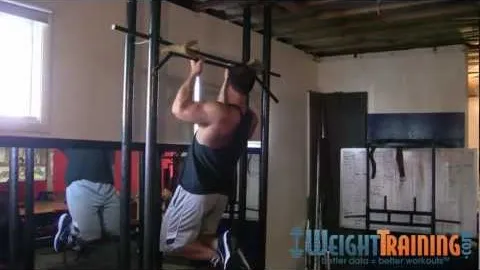

Are you looking to enhance your upper body strength and build a well-defined set of muscles? If so, incorporating the negative chin-up exercise into your workout routine can be extremely beneficial. Negative chin-ups are a challenging yet effective exercise that primarily targets the muscles in your back, shoulders, and arms, helping to improve overall upper body strength and muscular definition.
Negative chin-ups, also known as eccentric chin-ups, are a variation of the traditional chin-up exercise. While chin-ups typically involve pulling your body up towards the bar, negative chin-ups focus on the controlled lowering phase, which is when most of the muscle-building benefits occur. By emphasizing the eccentric phase, negative chin-ups effectively target and stimulate your muscles in a unique way.
Negative chin-ups target the muscles in your upper body, including your lats, biceps, and forearm muscles. As you lower yourself down from the bar, eccentrically engaging these muscles, you are effectively challenging and strengthening them. This exercise helps improve your upper body strength, making it easier to perform other compound exercises and tasks that require upper body power.
If you aim to develop a well-defined upper body, negative chin-ups can be a valuable addition to your workout routine. By stimulating and challenging the muscles in your back, shoulders, and arms, this exercise promotes muscular growth and definition. The controlled eccentric phase of the exercise applies tension to the muscles, leading to micro-tears in the muscle fibers. As these tears heal, the muscles become stronger, firmer, and more defined.
Grip strength is crucial for various athletic activities, such as rock climbing, weightlifting, and even everyday tasks like carrying grocery bags. Negative chin-ups require you to hold onto the bar tightly throughout the exercise, which helps improve your grip strength over time. Strengthening your grip can not only enhance your performance in other exercises but also reduce the risk of injuries that may occur while performing activities that involve gripping.
Although negative chin-ups primarily target the muscles in your back, shoulders, and arms, they also require you to engage your core throughout the exercise. Your core muscles work to stabilize your body as you lower yourself down, effectively strengthening them. A strong core not only enhances your overall stability and balance but also improves your posture and reduces the risk of back pain.
Follow these step-by-step instructions to perform negative chin-ups correctly:
When performing negative chin-ups, it's important to keep the following safety tips and considerations in mind:
Incorporating negative chin-ups into your workout routine can have numerous benefits for your upper body strength and muscular definition. This challenging exercise targets and stimulates the muscles in your back, shoulders, and arms, helping you build strength, enhance your muscular definition, and improve your overall physical performance. Remember to perform the exercise with proper form and safety considerations to maximize the benefits while minimizing the risk of injury. So, why not give negative chin-ups a try and take your upper body strength to new heights?
If you're looking for a gym, fitness club or yoga studio, you've come to the right place.
You can find information about gyms in your area. Browse catalog of gyms and find gyms with classes which are you looking for.
On gym page you can find simple information like address, phone or website. You can find list of available classes. You can check availability of personal training or small group classes. On place page you can also see information about open hours.
You can find gyms near you with amenities, courts, studios and equipments.
Use our map to find gym at your city or district.
In Gym Navigator you can find list of exercises with movies for many body parts.
You can browse exercises catalog and find exercises the best of you.
You can also find exercises grouped into workout plans, which you can use to improve you body. Each routine show you exercises one by one and give you possibility to count you progress and count down rest time.